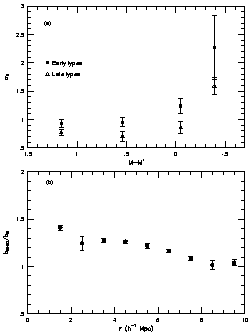


3.5 Small-scale Velocity Field
Redshift surveys can provide statistical estimates of deviations of
the Hubble flow on small scales, without requiring direct distance
measurements of individual galaxies. As discussed by
Davis & Peebles (1983)
this can be done by examining the correlation function  ,
as a function of the projected separation rp and redshift
separation
,
as a function of the projected separation rp and redshift
separation  of pairs. Deviations of
of pairs. Deviations of
 (rp,
(rp,
 ) from
concentric circles are due to redshift distortions, which provide
information on the distribution function of relative peculiar
velocities of galaxy pairs. On large scales, linear theory relates the
first moment of this distribution to the density parameter
) from
concentric circles are due to redshift distortions, which provide
information on the distribution function of relative peculiar
velocities of galaxy pairs. On large scales, linear theory relates the
first moment of this distribution to the density parameter  and the linear bias parameter b. On small scales, the cosmic virial
theorem connects the second moment to these parameters.
and the linear bias parameter b. On small scales, the cosmic virial
theorem connects the second moment to these parameters.
Analysis of redshift distortions observed the 1.2 Jy IRAS Survey lead
to estimates of  / b ~
0.4, from the cosmic virial theorem,
and
/ b ~
0.4, from the cosmic virial theorem,
and  =
=  0.6 / b = 0.45 on
scales ~ 10 h-1 Mpc
(Fisher et al. 1994).
Assuming that the relative bias between optical and
IRAS galaxies is bo / bI ~ 1.5 this
result implies that
0.6 / b = 0.45 on
scales ~ 10 h-1 Mpc
(Fisher et al. 1994).
Assuming that the relative bias between optical and
IRAS galaxies is bo / bI ~ 1.5 this
result implies that
 8
8  0.6 ~ 0.3, where
0.6 ~ 0.3, where  8 is the rms mass
fluctuation within a sphere 8 h-1 Mpc in radius.
Unfortunately, both
estimates suffer from either large systematic errors or large cosmic
variance, due to the limited number of independent structures sampled
by the nearby surveys. This has been vividly illustrated by the large
sample-to-sample variations of the relative velocity dispersion
between pairs derived from the combined CfA2-SSRS2 sample
(Marzke et al. 1995).
The finding that this quantity shows strong
sample-to-sample variations indicates that it is poorly determined
within the volume surveyed, being dominated by the shot-noise
contribution of clusters. One is forced to conclude that at the
present time the small-scale velocity field is not a powerful
discriminant among competing cosmological models. Even though new
statistics have recently been proposed to overcome the effects of a
pair-weighted statistic
(Davis et al. 1997,
Strauss et al. 1998),
it is clear that for robust measurements
considerably larger volumes, sampling a fair number of clusters of
different richness, are required. This will certainly be possible with
the next generation of surveys. It is worth pointing out that the
estimates of
8 is the rms mass
fluctuation within a sphere 8 h-1 Mpc in radius.
Unfortunately, both
estimates suffer from either large systematic errors or large cosmic
variance, due to the limited number of independent structures sampled
by the nearby surveys. This has been vividly illustrated by the large
sample-to-sample variations of the relative velocity dispersion
between pairs derived from the combined CfA2-SSRS2 sample
(Marzke et al. 1995).
The finding that this quantity shows strong
sample-to-sample variations indicates that it is poorly determined
within the volume surveyed, being dominated by the shot-noise
contribution of clusters. One is forced to conclude that at the
present time the small-scale velocity field is not a powerful
discriminant among competing cosmological models. Even though new
statistics have recently been proposed to overcome the effects of a
pair-weighted statistic
(Davis et al. 1997,
Strauss et al. 1998),
it is clear that for robust measurements
considerably larger volumes, sampling a fair number of clusters of
different richness, are required. This will certainly be possible with
the next generation of surveys. It is worth pointing out that the
estimates of  on
small scales are consistent with the most
recent estimates of this parameter from cosmic flows (e.g.,
da Costa et al. 1998).
on
small scales are consistent with the most
recent estimates of this parameter from cosmic flows (e.g.,
da Costa et al. 1998).

|
Figure 4. Linear biasing measures for early/late-type galaxies. Panel (a) shows the variance for different luminosity thresholds while panel (b) shows the relative bias between early and late types as a function of scale (for details see Willmer et al. 1998). |